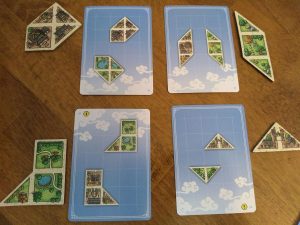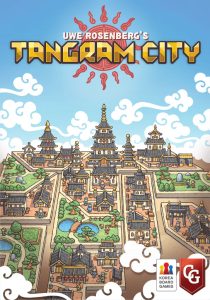 Uwe Rosenberg has mastered the polyomino in board games, but how’s he doing with tangrams? (Traditionally, a tangram is a Chinese geometric puzzle consisting of a square cut into seven pieces that can be arranged to make various other shapes.)
Uwe Rosenberg has mastered the polyomino in board games, but how’s he doing with tangrams? (Traditionally, a tangram is a Chinese geometric puzzle consisting of a square cut into seven pieces that can be arranged to make various other shapes.)
Tangram City is a tile placement game from Capstone Games designed by Uwe Rosenberg for 1-5 players that plays in about 20-40 minutes. Will you build the best city and be rewarded with all the riches of the kingdom?
Gameplay Overview:
 In Tangram City, players earn points by filling their City Board with tangram-shaped City Tiles. Everyone begins with an identical set of 23 two-sided City Tiles, red on one side, green on the other. Over 6 rounds, players will place their tiles based on cards that are dealt at the beginning of each round. Four cards are distributed among the players, which can lead to shared cards and some cards being placed face-up or face-down on the table, depending on player count. Cards in the middle of the table are played first, then each player reveals their card in turn order. For every card, all players take the corresponding tangram tile shape from their personal supply and place it into their City.
In Tangram City, players earn points by filling their City Board with tangram-shaped City Tiles. Everyone begins with an identical set of 23 two-sided City Tiles, red on one side, green on the other. Over 6 rounds, players will place their tiles based on cards that are dealt at the beginning of each round. Four cards are distributed among the players, which can lead to shared cards and some cards being placed face-up or face-down on the table, depending on player count. Cards in the middle of the table are played first, then each player reveals their card in turn order. For every card, all players take the corresponding tangram tile shape from their personal supply and place it into their City.
Once all of the cards have been used for a round, scoring takes place. Players score a point for each space covered by their largest rectangle of placed tiles. Then everyone moves their red and green balance markers based on the number of green and red tile spaces showing in their City.
At the end of the game, red and green balance is checked and bonus points are awarded to players who’ve managed to be most in balance (whoever got closest to placing as many tiles of one color as the other). The player with the most points wins.
Game Experience:
Tangram City is a very simple game mechanically. Each turn, you’ll have only one choice of tile to place and you put it on your board. Scoring is also straightforward as you just have to focus on expanding a large rectangle within your City. There’s not much depth beyond that, aside from trying to think ahead and determine where it’s best to place the current tile. Early on in the game, it seems like it’ll be a cinch to just keep growing your rectangle, but eventually, you’ll realize that the shapes and sizes of tiles are becoming less helpful in filling those gaps.
 At the end of each round, you receive one fountain tile that can be placed anywhere, which takes up half a square on the board. It helps you fill in strange holes that have cropped up in your city. You’ll also need to think ahead a bit to try and keep the red and green balanced enough to get those crucial end-game points.
At the end of each round, you receive one fountain tile that can be placed anywhere, which takes up half a square on the board. It helps you fill in strange holes that have cropped up in your city. You’ll also need to think ahead a bit to try and keep the red and green balanced enough to get those crucial end-game points.
For the most part, your ability to strategically cover up as much of your board as possible is left to chance. If you’ve banked on a certain tile shape coming up soon and that card isn’t flipped until the end of the game, then there’s nothing you can do about it. The way the cards are dealt each round allows for a bit of tactical maneuvering, but it’s fairly superficial. You’ll have your one card in hand, which gives just the slightest bit of foreknowledge, but it’s still rooted in chance. If you go early in the round, then it doesn’t help much to know your card is the next one before placing a tile, for instance.
That’s pretty much all there is to it. In Tangram City, you’re basically just trying to fill up a grid with strangely shaped tiles and balance the colors showing on those tiles.
Final Thoughts:
Uwe Rosenberg has managed to design some pretty intricate and deep board games using polyominos as a central mechanism. I think there’s potential in a tangram-based game, but I’m not sure Tangram City really nails it. It’s a little too simplistic, with the goal being just to fill up a rectangle with your shapes. Tangram puzzles, where you have to orient different shapes together in order to complete a larger image, can be interesting brain burners and such a mechanism would have made this a much more engaging game. Perhaps they tried it in playtesting and couldn’t make it work, or maybe the simpler ruleset is what they were going for. In any case, I can’t help but wonder what a slightly weightier version might have been like.
My desire for more depth aside, it’s still a fun enough puzzle for a short gaming session, and I’m sure more casual game groups could get some mileage out of Tangram City.
Final Score: 3 Stars – An easy to play tile placement game with simple rules.
 Hits:
Hits:
• The production quality is solid
• It’s a satisfying puzzle with low mental effort
Misses:
• There’s not much depth to just filling up a rectangular shape
• Chance plays a part in whether you’ll be able to complete your grid
Source: Board Game Quest






